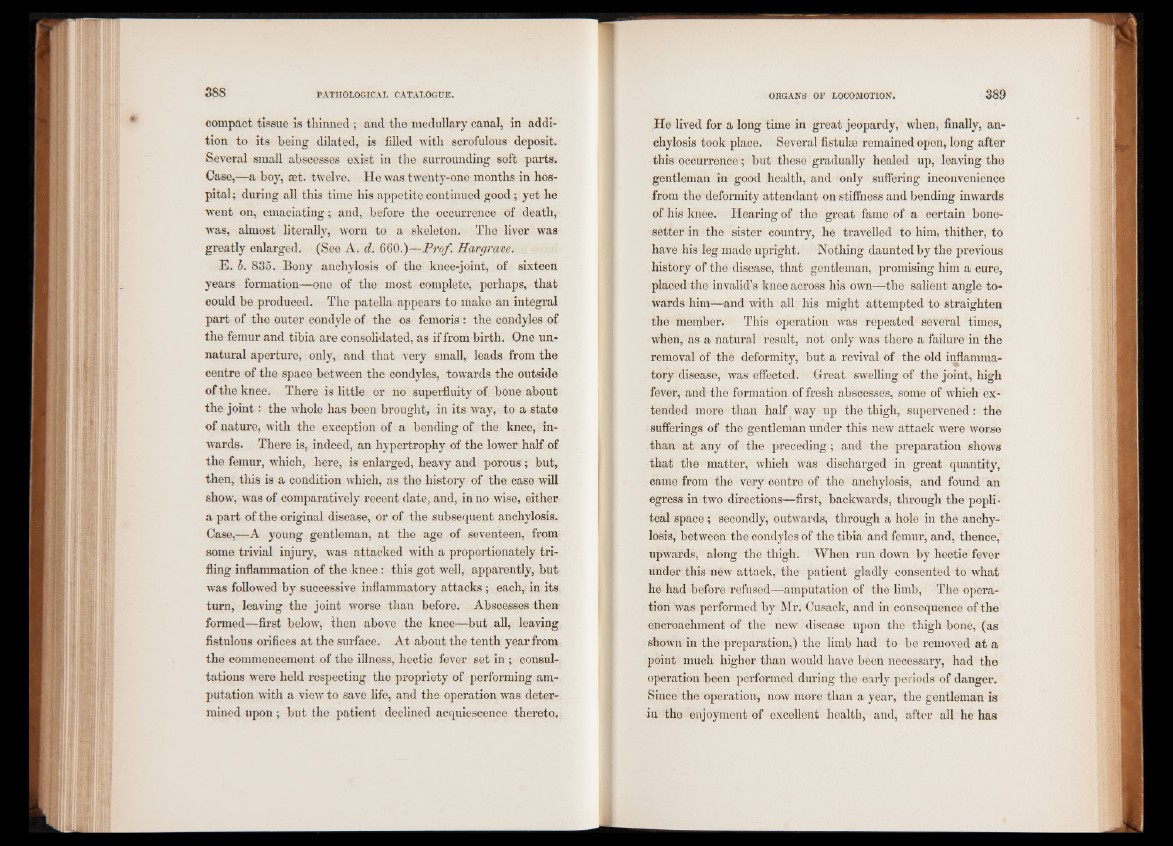
compact tissue is thinned ; and the medullary canal, in addition
to its being dilated, is filled with scrofulous deposit.
Several small abscesses exist in the surrounding soft parts.
Case,—a boy, set. twelve. He was twenty-one months in hospital
; during all this time his appetite continued good; yet he
went on, emaciating; and, before the occurrence of death,
■ was, almost literally, worn to a skeleton. The liver was
greatly enlarged. (See A. d. 660.)—Prof. Hargrave.
E. h. 835. Bony anchylosis of the knee-joint, of sixteen
years formation—one of the most complete, perhaps, that
could be produced. The patella appears to make an integral
part of the outer condyle of the os femoris : the condyles of
the femur and tibia are consolidated, as if from birth. One unnatural
aperture, only, and that very small, leads from the
centre of the space between the condyles, towards the outside
of the knee. There is little or no superfluity of bone about
the joint: the whole has been brought, in its way, to a state
of nature, with the exception of a bending of the knee, inwards.
There is, indeed, an hypertrophy of the lower half of
the femur, which, here, is enlarged, heavy and porous ; but,
then, this is a condition which, as the history of the case will
show, was of comparatively recent date, and, in no wise, either
a part of the original disease, or of the subsequent anchylosis.
Case,—A young gentleman, at the age of seventeen, from
some trivial injury, was attacked with a proportionately trifling
inflammation of the knee: this got well, apparently, but
was followed by successive inflammatory attacks; each, in its
turn, leaving the joint worse than before. Abscessed then
formed—first below, then above the knee—but all, leaving
fistulous orifices at the surface. At about the tenth year from
the commencement of the illness, hectic fever set in ; consultations
were held respecting the propriety of performing amputation
with a view to save life, and the operation was determined
upon; but the patient declined acquiescence thereto.
He lived for a long time in great jeopardy, when, finally, anchylosis
took place. Several fistulae remained open, long after
this occurrence; but these gradually healed up, leaving the
gentleman in good health, and only suffering inconvenience
from the deformity attendant on stiffness and bending inwards
of his knee. Hearing of the great fame of a certain bone-
setter in the sister country, he travelled to him, thither, to
have his leg made upright. Nothing daunted by the previous
history of the disease, that gentleman, promising him a cure,
placed the invalid’s knee across his own—the salient angle towards
him—and with all his might attempted to straighten
the member. This operation was repeated several times,
when, as a natural result, not only was there a failure in the
removal of the deformity, but a revival of the old inflammatory
disease, was effected. Gfreat swelling of the joint, high
fever, and the formation of fresh abscesses, some of which extended
more than half way up the thigh, supervened: the
sufferings of the gentleman under this new attack were worse
than at any of the preceding; and the preparation shows
that the matter, which was discharged in great quantity,
came from the very centre of the anchylosis, and found an
egress in two directions—first, backwards, through the popliteal
space ; secondly, outwards, through a hole in the anchylosis,
between the condyles of the tibia and femur, and, thence,
upwards, along the thigh. When run down by hectic fever
under this new attack, the patient gladly consented to wrhat
he had before refused—amputation of the limb, The operation
was performed by Mr. Cusack, and in consequence of the
encroachment of the new disease upon the thigh bone, (as
shown in the preparation,) the limb had to be removed at a
point much higher than would have been necessary, had the
operation been performed during the early periods of danger.
Since the operation, now more than a year, the gentleman is
in the enjoyment of excellent health, and, after all he has